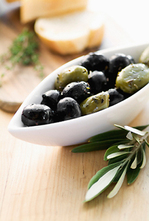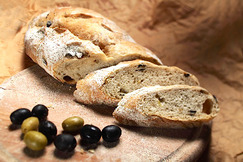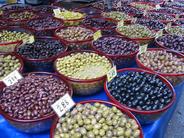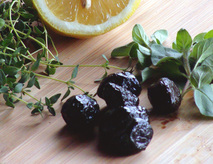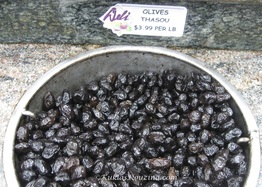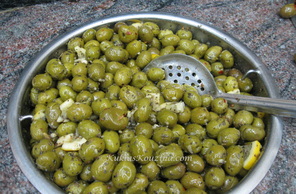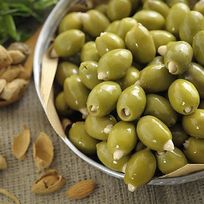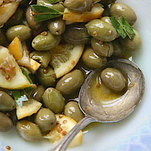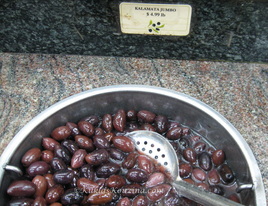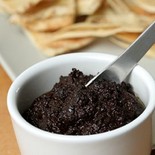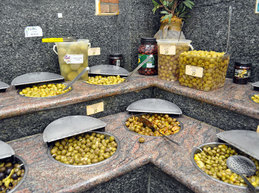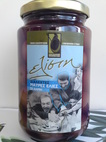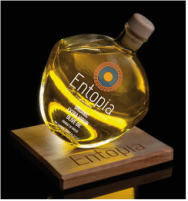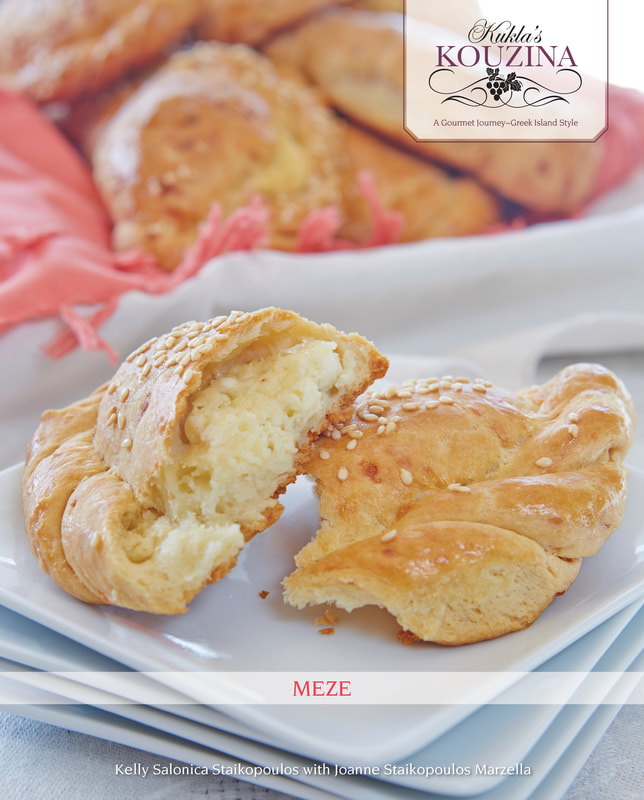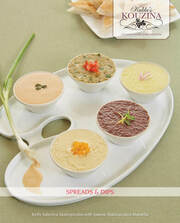Olive Oil Odyssey

health
Olive oil (extra virgin) contains monounsaturated fatty acids (MUFAs). The health benefits from MUFAs in extra-virgin olive oil include reducing the risk of heart disease, lowering overall cholesterol, benefiting those with type 2 diabetes, and can assist in cancer prevention. Olive oil also has anti-inflammatory properties. Preparing foods using olive oil instead of butter or margarine can help make you healthier on the inside. In addition to eating, ancient Greeks applied it (in small amounts) directly to the skin and hair to moisturize and protect from the elements, making them more beautiful on the outside.

Since you’re totally into olive oil and the whole Mediterranean-diet thing, you’re ready to set out on a journey to buy that special olive oil that will add flavor, and good health, to your life. Once at the market, you make a beeline for the oil aisle. You’re now standing in front of the olive oils, your eyes widen, your mouth drops open and you suddenly realize you need a GPS to figure out which direction to go in. The choices are so seemingly endless—cold-pressed, unfiltered, extra virgin, pure, light—that you end up wondering if you should grab the prettiest bottle or just run for the exit. (NOTE: Good olive oil does NOT come in plastic. Look for glass bottles or cans.)
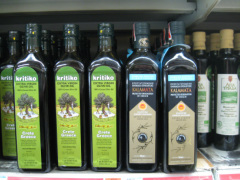
Olive oils are categorized based on their degree of acidity. The lower the acidity, the more fruity and flavorful the oil. When you see “cold-pressed” on the label it means the oil was extracted from the olives using a chemical-free process (applying only pressure), producing a natural, low-acidity level—a good thing! “Unfiltered” means that the oil did not undergo a filtering treatment, leaving tiny particles of olive fruit (the gist) in the oil, which translates into more flavor in the oil and less handling when it comes to processing—a purist’s dream!
Extra virgin olive oil, the cold-pressed, first pressing of the olives, is 1 percent or less acid (the lowest acidity of all the olive oils). This is the fruitiest and most expensive olive oil so you wouldn’t use it much for cooking (high heat/frying can break down the flavor so it would be a waste) but it’s the ONLY oil you’d want to eat raw, like on salads, drizzled over cooked foods, and for dipping (think fresh, crusty bread!).
Virgin olive oil is also a first press oil but with a slightly higher acidity of 1 to 3 percent. Good for low- or medium-heat cooking (when you want the flavor of the olives in your food) and eating raw (though not as flavorful as extra virgin).
Fino olive oil is an extra-virgin and virgin blend. Also good for low- or medium-heat cooking and eating raw.
Olive oil or pure olive oil is a blend of refined olive oil (chemicals are used to extract the oil from the olives) and virgin or extra virgin. Not so “pure,” huh? The chemicals are enough of a reason to stay away from this one!
Light olive oil is lighter in color and olive flavor because it has undergone an extremely fine filtration process, which gives it a higher smoke point, making it ideal for high-heat frying. Because of its bland flavor, it’s perfect for the kind of baking or cooking where a more flavorful olive oil would be overpowering. If you want the benefits of olive oil but not the rich taste, then this is the all-purpose oil for you.
Our Kukla’s basic rule of thumb was “the darker green the color is, the better the olive oil will be.” She was right of course! The deeper the color, the more intense the olive favor. But sometimes it’s hard to tell as some bottles are tinted to protect the oil from light, which can cause it to oxidize and loose its fruity flavor and health-promoting nutrients. In ancient times, olive oil was stored in animal skins, which was great for protecting it from the elements but, because of its contact with an animal product, it was a restricted food when fasting or during Lent, a practice/tradition still observed to some extent by the Greek Orthodox church today.
olive oil fraud
The sale of fake extra-virgin olive oil has been a major issue of late. The phony olive oil is usually diluted with inexpensive soybean or sunflower oil, or it’s combined with chemically-refined olive oil. To find out if your EVOO is real, refrigerate it overnight. If it solidifies in the refrigerator, it’s most likely the real deal (unless it was mixed with a lower grade olive oil). Genuine olive oil smells and tastes fresh and vibrant, so go with your senses! Check out the Olive Oil Times for more on this subject.
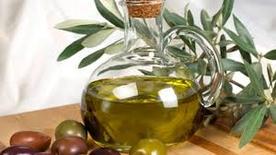
The best olive oils are imported and the primary countries they come from are in the Mediterranean—Greece, Italy, Spain, and France. The growing region, soil components, and climate greatly affect the flavor, color, and aroma of the olive oil produced. For these reasons, the olive oils from Greece have achieved an unsurpassed level of excellence, which is why they’re so coveted worldwide.
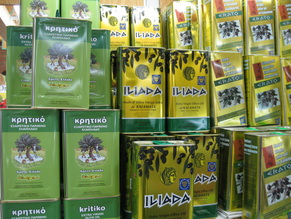
In the end it really comes down personal to taste, so narrow down your choices, buy a small bottle, and try it out. If you’re happy with it, you can go back for a larger bottle or can. If there’s room for improvement, try a different one. Make it a tasty adventure of discovery and enjoy the journey to good food and good health! As Kukla would say "Stin iyia sou!" To your health!
You’ve got your bottle of olive oil, now what? Store it in a cool, dark place, like your kitchen cupboard (away from the stove) for up to 6 months. If you use a lot of it, you can buy a large can (which is less expensive than buying it by the bottle) and pour it into a tinted bottle fitted with a spout (wine bottles are perfect, just wash them out first). That way you can refill the bottle as needed and keep the bulk of the oil stored and protected.

Enjoy your olive oil in this fresh summertime pasta dish and start your own Odyssey!
Pasta with Tomatoes, Kalamata Olives, and Feta
A refreshing and tasty recipe with authentic Greek flavor that's quick and easy to make!
Serves 3 to 4 people
Ingredients
1 ¾ pounds pasta (any shape is fine)
3 or 4 tomatoes, seeded and cut into 1/2-inch pieces or
1 pint cherry tomatoes, halved
9 ounces imported feta cheese, crumbled
1/2 cup pitted kalamata olives
3 tablespoons drained capers
2 teaspoons fresh thyme leaves
1/4 teaspoon sea salt, plus more for cooking pasta
1/8 teaspoon freshly-ground black pepper
1/3 cup extra-virgin olive oil, plus more for drizzling
Fresh flat-leaf parsley, for garnish
Preparation
1. Cook the pasta according to package directions until al dente. Drain.
2. Meanwhile, in a large heatproof serving bowl, combine the tomatoes, feta, olives, capers, thyme, salt, and pepper.
3. In a medium skillet, heat the olive oil over moderately low heat until hot but not smoking, about 1 minute. Add the cooked drained pasta to the olive oil and toss just until coated and heated through, about 1 minute. Remove from heat, add the pasta and any oil in the skillet to the tomato mixture, and toss until combined. Lightly drizzle with olive oil and garnish with parsley, if desired.
Serve and enjoy!
Recipe © copyright Kukla's Kouzina: A Gourmet Journey~Greek Island Style, kuklaskouzina.com
Mentis Estate
Titan Foods (Astoria, NY)
Mediterranean Foods (Astoria, NY)
We hope you had fun in this one-on-one with olive oil. For more on the process of making olive oil with a visit to our favorite producer, Mentis Estate, read next week's blog: Olive Oil~Branch to Bottle. Stay tuned for more upcoming blogs on Greek ingredients, with recipes that will make them shine!
Sign up for our e-newsletter (if you haven’t already) and stay connected on social media for cooking tips and recipes, as well as for all Kukla's Kouzina updates and news.
Thanks for following us and we’ll see you next Monday.
Until then~
Kali orexi! Good appetite!
Kelly
Mayo Clinic: Mediterranean Diet for Heart Health
CNN: The 5 Things You May Not Know About Olive Oil
Whole Foods: The World’s Healthiest Foods
Web design by Kelly Salonica Staikopoulos

